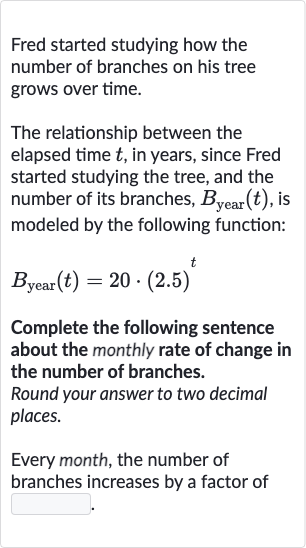AI tutor
Welcome to Bytelearn!
Let’s check out your problem:

Fred started studying how the number of branches on his tree grows over time.The relationship between the elapsed time , in years, since Fred started studying the tree, and the number of its branches, , is modeled by the following function:Complete the following sentence about the monthly rate of change in the number of branches.Round your answer to two decimal places.Every month, the number of branches increases by a factor of
Full solution
Q. Fred started studying how the number of branches on his tree grows over time.The relationship between the elapsed time , in years, since Fred started studying the tree, and the number of its branches, , is modeled by the following function:Complete the following sentence about the monthly rate of change in the number of branches.Round your answer to two decimal places.Every month, the number of branches increases by a factor of
- Understand function representation: Understand the given function and what it represents.The function represents the number of branches on the tree after years. To find the monthly rate of change, we need to express in months instead of years.
- Convert time to months: Convert the time from years to months.Since there are months in a year, we need to find the equivalent monthly growth factor. Let's denote as the number of months. Then, (in years) is equal to (since months is years).
- Rewrite function in terms of months: Rewrite the function in terms of months.The new function in terms of (months) will be .
- Calculate monthly growth factor: Calculate the monthly growth factor.We need to find the value of to determine by what factor the number of branches increases each month.
- Evaluate growth factor: Evaluate using a calculator. (rounded to four decimal places for intermediate calculation).
- Round growth factor: Round the monthly growth factor to two decimal places as instructed.The monthly growth factor rounded to two decimal places is approximately .
More problems from Compound interest: word problems
QuestionGet tutor help
QuestionGet tutor help
QuestionGet tutor help
QuestionGet tutor help
QuestionGet tutor help
QuestionGet tutor help
QuestionGet tutor help
QuestionGet tutor help
QuestionGet tutor help
